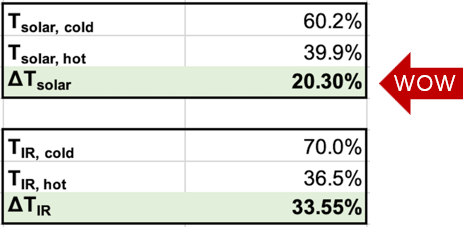Technology
Energy from the Sun
Most of the energy that comes from the Sun is in the infrared spectrum, around 58%. While we experience solar heat gain from visible light, the majority actually comes from the infrared portion of the spectrum, invisible to the human eye.
The graph shows light energy from the Sun that penetrates Earth’s atmosphere across the spectrum from UV to NIR.
Remarkable Performance, 2023
This spectrograph shows light energy transmitted through IRD's coated glass in the cold state (blue line) and hot state (red line). This sample had 61% visible light transmission and was not color-corrected. ΔT indicates the difference by % between the hot and cold states. ΔT solar is the total difference across the full spectrum from 300 (nm) to 2500 (nm).
Transmittance is corrected for solar radiance at North America Latitude.
All spectral data is compiled using IRD’s Cary 5000 spectrophotometer.
Vanadium Dioxide Nanoparticles
Over the past 20 years, many companies, universities, and National Labs around the world have explored the amazing properties of Vanadium Dioxide (VO2) and many papers have been written about the potential energy saving that the technology promises. Bringing a high-performing VO2 coating into the market has been a challenge unmet until now. IRD has broken the barriers that have kept this material from entering the marketplace and, following 8 years of development, is moving quickly toward commercialization.
What Makes IR Dynamics Unique?
IR Dynamics has solved all the critical problems required to commercialize VO2 nanomaterials.
Pilot Production
IRD has been working for 8 years to solve the many technical hurdles necessary to bring VO2 thermochromic glass to reality. IRD's initial pilot plant will be constructed at its current facility in New Mexico, USA. This plant will produce enough nanomaterials to coat up to 1.4M square meters per year. (~15M ft.2)
IRD’s Color Control
IR Dynamics has developed Molecular Color Control to shift the natural yellow color of VO2-based thermochromic coatings to an industry-acceptable grey tint.











